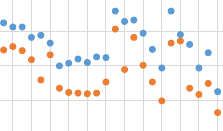
Perlin noise, a type of procedural noise, was used for the design of elevation files for 2.5D printing. This printing method uses elevation data from a height map to create physical relief by superimposing layers of ink. In this experiment, the grayscale values of noise functions were used as elevation values to build different surface structures in UV curable ink by 2.5D printing. Printed samples with varying levels of Perlin noise were created and their reflectance properties were studied by measuring the values of specular gloss. The roughness and specular gloss of the printed surfaces were effectively influenced when varying the persistence and octaves of the noise functions. The aim of implementing the procedural approach to a high-resolution printing method has been to explore the reflectance properties of custom noise functions when transferred to the physical realm. This might contribute to better understand the effect of surface structure on the appearance of materials. Potentially, this approach will enable the use of relief printing to produce structures with a more natural appearance and a desired gloss value by using a low-cost computing process.
Abigail Trujillo Vazquez, Donatela Šarić, Susanne Klein, Carinna Parraman, "Influence of procedural noise on the glossiness of 2.5D printed patches" in Proc. IS&T 29th Color and Imaging Conf., 2021, pp 105 - 110, https://doi.org/10.2352/issn.2169-2629.2021.29.105
